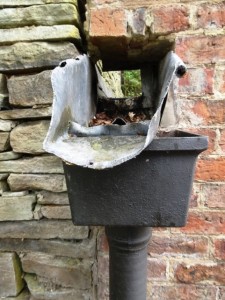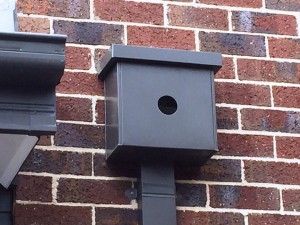08 Oct Whatever Happened to Rain Heads???
IMPORTANT CLAIMS HANDLING UPDATE
Any blog post in the Metropolis Solutions Blog Archive that includes any direct or indirect reference to insurance claims handling of any nature whatsoever, including any reference to existing and/or potential claims, was posted prior to 01.07.21, is for general information only and may also no longer be applicable due to recent changes in Federal Financial Services laws concerning claims handling. Please note that Metropolis does not hold an Australian Financial Services (AFS) Licence for claims handling and therefore qualified expert assistance on any insurance related matter, including Victorian Plumbers Warranty, should now be sought from a suitable lawyer or other expert holding an AFS claims handling licence. Metropolis Solutions can still consult on insurance claims handling matters, but only in the instance where we are directly engaged to do so by your authorised legal representative.
- A sad story of ‘pretty’ buildings and failure of enforcement
- Why your new house, multi unit residential apartment or commercial property is probably at extremely high risk of internal flooding
A long time ago when humans first started constructing buildings, smart people worked out how to get water off roofs. Doing that correctly was obviously pretty important.
Anybody who has ever visited a large cathedral or a castle will also have seen gargoyles; they aren’t just there to scare away bad spirits – most of them are also designed to spout water away from the roof of a building during rain. One of the best examples is Basilica-di-San-Marco in Venice where a literal arsenal of gargoyles designed like spouts is beautifully integrated in the ornate face of the building, where they act like guns to fire water away from the roof areas in heavy rain. Here’s a picture (the dark coloured gargoyles/spouts run across the photo left to right through the centre):
Other clever builders then came up with what was called a “rain head”; this is a metal box that sits outside of the building line. It takes water from the roof (normally through a concealed box gutter), then directs it away via a down pipe. As the water depth increases in the rain head, hydraulic pressure and gravity work to force the water down the pipe even faster. It’s a very clever idea, but part of the centuries old design also included a fail safe feature to make sure the water still got away from the building even if it blocked up for some reason. Here’s a classic example where you can see that if the rainhead (the metal box) blocks up, the storm water still continues to flood out over the spillway leading from the box gutter, where it falls harmlessly outside the building:
Some of the best examples of this can be seen in the UK where apart from the same sorts of castles and churches like in Europe, all major old buildings including mills, large country estate houses and even Royal Palaces were fitted with these very clever and effective devices designed long, long ago.
One way or the other, our ancestors had this all worked out centuries ago. Then we lost the plot.
The only trouble with the original but well proven, centuries old rain head design was that there needed to be a large hole in the parapet wall of the building for the water to flow through and into the rainhead from. That hole in the building can be seen in the previous picture. Early on it really didn’t matter because they were normally very high up and you couldn’t see much, but as buildings got lower people then wanted to cover up the hole because it was ugly – and who wanted to stare into the ‘works’ of a building roof all the time??
Enter the modern designed rainhead (below) linked to a ‘box gutter’ hidden behind the wall and which solved this visual issue – but then created a whole lot more problems.
So what’s wrong with today’s rainheads?? Unfortunately, plenty.
The fundamental lesson learned centuries ago about overflow provision (if it blocks) has been forgotten. All it takes is a pile of leaves, a plastic bag or a birds nest and the downpipe blocks in the bottom of the rainhead. During rain, storm water continues to pour in from the roof area behind and if the rainhead is blocked, suddenly it has nowhere to go. This is why dams have always had an emergency weir or spillway for an overflow mechanism.
Some plumbers cut a hole in the rainhead (as can be seen above) as the overflow provision, but the hole is hopelessly inadequate in size compared to the large box gutter behind that is feeding it – in Australian Standards some of these rainheads have to get rid of 16 litres of stormwater A SECOND !!!! This means that the rainhead just can’t manage what’s going on so the rainhead fills up completely then backs up with water along the box gutter behind. The box gutter then overflows, flooding the building inside – often causing catastrophic damage. This can occur in only seconds or maybe minutes depending on the severity of the storm. You may as well have stuck a complete dam over the end of the box gutter. The design is a complete shambles.
An enormous number of flooded buildings are as a result entirely caused by this simple but very stupid design and installation oversight. They are not flooded by “storms”. The losses to the insurance industry in Australia alone must be in the hundreds of millions if not billions every year.
The next ridiculous part is that authorities in Australia recognized the problem years ago and made specific regulations to ensure overflow provision on rainheads. AS/NZS3500.3 provides two drawings for a compliant rain head, both of which mirror the centuries old design. AS/NZS3500.3 also contains an obligation that rainheads must be able to cope with and if necessary safely overflow outside of the building ‘to atmosphere’ in a 1 in 100 year rainfall event for the particular location where they are installed. In Melbourne that’s a huge 186mm of rain falling in just an hour.
Yet it gets even more ridiculous:
- Nobody has made rainheads in Australia that even comply with AS/NZS3500.3 so there’s no chance one is fitted to your property
- Manufacturers seem to have just ignored the standards
- A number of manufacturers even allow customers to ‘custom design’ their own rainhead on line; these also don’t comply with AS/NZS3500.3
- Too many plumbers are ignorant of the standards as well but even if they were aware, they could not buy a compliant rainhead even if they wanted to
- Architects too are often unaware of the standards and not trained in this area; virtually every Architect designed house we see has this basic fault
- Regulatory authorities across the country have then totally failed to enforce compliance with the standards – something which should have driven a solution years ago
As a result of this, thousands of these non-compliant rainheads are being installed across Australia every day.
If your property is fitted with rainheads it is virtually certain that they are NOT compliant with the mandatory Australian Standards. This makes your property a major flood risk from virtually any weather event but especially larger storms. This single defect also explains a significant number of the ‘leaking building syndrome’ cases across Australia.
In Victoria (but not other states) it’s fortunate that you can make a claim against the installing plumber to have the situation fixed at no cost to you provided you make the claim against the plumber within 6 years – that’s if the plumber can ever make it compliant. Your claim will also cover the cost of fixing any damage which has been caused.
The Victorian Building Authority is well aware of this issue and in October 2014 even issued a bulletin to all plumbers, but it’s still being ignored by everyone due to lack of enforcement and no availability of any compliant rainheads. The lack of action is also quite possibly due to the VBA itself not knowing what the answer was: http://www.vba.vic.gov.au/__data/assets/pdf_file/0012/24510/Overflow-provisions-for-box-gutters.pdf
Fortunately the penny finally dropped with the folks over at Dam Buster who have just introduced the ONLY AS/NZS3500.3 certified rainhead for box gutters. Decades late, these fantastic devices have made every single other rainhead on the market redundant overnight and given plumbers and home owners the rainhead they need – one that actually works – and which will also protect your property from very severe rain events.
If you are building, renovating or planning to use rainheads, you should INSIST on your plumber using Dam Buster certified rainheads.
More on this amazing and patented Australian invention can be found at www.dambuster.com.au
We suggest that plumbers with supplier or technical inquiries should visit the Dam Buster web site or else contact [email protected]




Sorry, the comment form is closed at this time.